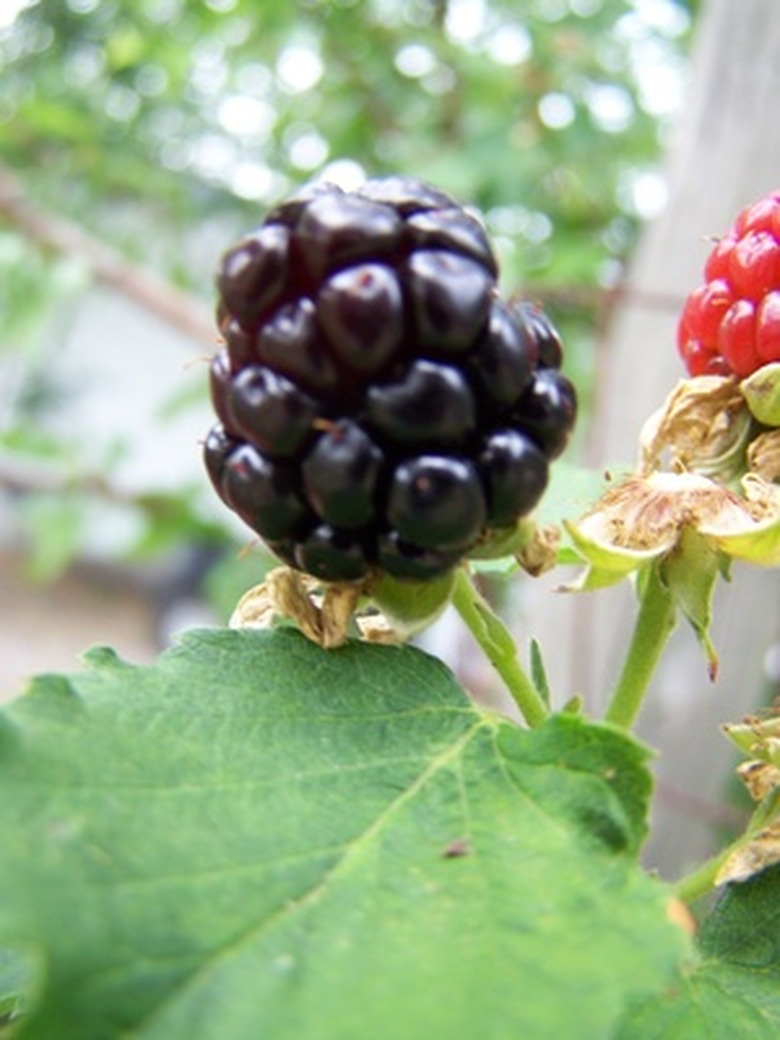How To Grow Blackberry Bushes In Minnesota
Things Needed
- pH soil test kit
- Ground rock sulfur
- Organic compost
- Tiller
- Shovel
- Water
- Bucket
- 10-10-10 fertilizer
- Mulch
- Pruning clipper
Blackberries are a bramble fruiting plant, with the berries being produced only on two-year-old canes. The canes are grouped together in rows which have the appearance of bushes. Blackberries are native to North America and hardy to plant in USDA growing zones 5 through 8. It is possible to plant blackberry canes in southern Minnesota where the growing zone is 4b, as long as the canes are winterized for protection.
Step 1
Select a blackberry cane planting location that has full sunlight, good air circulation and a well-draining soil. Do not plant blackberries in soil that previously grew tomatoes, potatoes, peppers or eggplants.
Step 2
Prepare the planting area soil the year prior to planting blackberry canes. Remove all vegetative growth and test the soil pH as blackberry canes grow best in a slightly acidic soil with a pH of 5.5 to 7.0. Work in ground rock sulfur to lower the pH number (follow packaging instructions for how much to add).
- Blackberries are a bramble fruiting plant, with the berries being produced only on two-year-old canes.
- It is possible to plant blackberry canes in southern Minnesota where the growing zone is 4b, as long as the canes are winterized for protection.
Step 3
Add 3 to 4 inches of organic compost to the soil to increase the nutrient content and moisture retention qualities. Use a tiller to work the compost into the ground to a depth of 8 to 10 inches.
Step 4
Plant one-year-old canes in early spring. Soak the roots of bare root plants in a bucket of water for several hours. Dig a hole that is wide enough for the roots to spread out and the same depth as the cane was previously growing.
Step 5
Set the plant in the hole and gently tamp the soil to hole the cane in place. Space erect blackberry varieties 4 feet apart and trailing varieties 8 feet apart.
- Add 3 to 4 inches of organic compost to the soil to increase the nutrient content and moisture retention qualities.
- Dig a hole that is wide enough for the roots to spread out and the same depth as the cane was previously growing.
Step 6
Water the canes generously immediately after planting. Continue to water blackberry canes with 1 inch of water each week. Increase the water amount once the canes produce berries so each plant receives approximately 2 gallons of water each day.
Step 7
Fertilize blackberry canes 3 to 4 weeks after planting with a 10-10-10 fertilizer once the canes begin to grow. Apply fertilizer to established plants in early spring before the canes begin to produce flowers.
Step 8
Apply a 2 to 3 inch layer of pine straw or wood chip mulch around the base of the blackberry canes to reduce weed growth and increase moisture retention in the soil.
Step 9
Prune erect blackberry canes each spring by removing dead or damaged canes. Summer prune the blackberry canes to remove three inches from the top. Remove canes that produced fruit once the harvest is complete.
- Water the canes generously immediately after planting.
- Summer prune the blackberry canes to remove three inches from the top.
Step 10
Winterize blackberries by bundling 2 to 3 canes together while they are still planted into the ground, bend the canes over without breaking them and cover the canes with topsoil or mulch to protect the roots. Remove the mulch when the soil beings to thaw in spring and gently pull the canes upright to begin growth.
Tip
Erect growing cultivars that can be planted in Minnesota are Darrow, Cheyenne and Illini Hardy. Semi-erect cultivars are Chester and Triple Crown.
